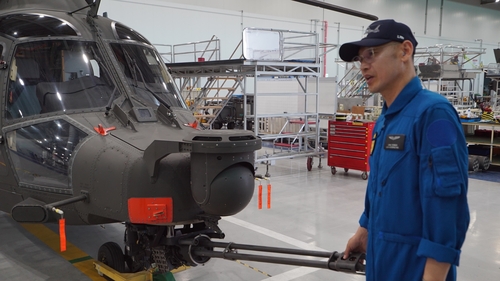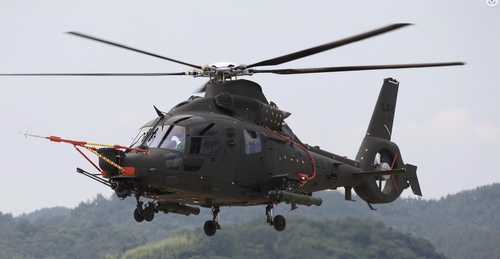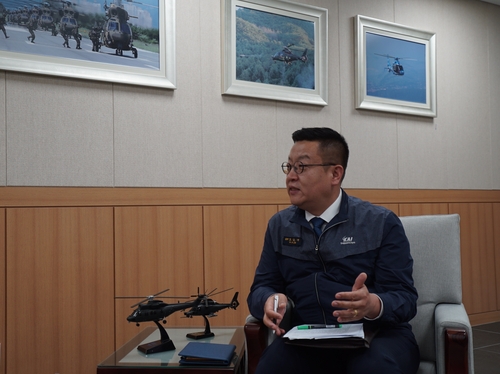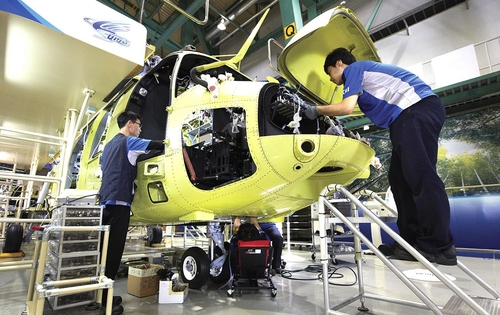By Kim Eun-jung
SACHEON, South Korea, May 19 (Yonhap) — Korea Aerospace Industries Ltd. (KAI) has sold FA-50 fighter aircraft and KT-1 trainer jets abroad, but it has not yet achieved its goal of exporting helicopters. After years of failed attempts, South Korea’s sole aircraft maker believes its long-sought goal is finally coming to fruition soon.
KAI is the manufacturer of the Korean Utility Helicopter (KUH), known as Surion, a medium-sized utility helicopter deployed in the South Korean Army since 2012. Its variants are used in the Marine Corps, police, Coast Guard, firefighting, medical evacuation, forest service and more.
To leverage the technological know-how in the chopper field, KAI developed a Light Armed Helicopter (LAH) from 2015 to 2022 to replace the Army’s aging fleet of U.S.-origin 500MD Tow and Bell AH-1S Cobra attack helicopters.
Engineers of Korea Aerospace Industries (KAI) assemble parts of the Light Armed Helicopter in the assembly line in Sacheon, about 300 kilometers southeast of Seoul, in this photo provided by KAI. (PHOTO NOT FOR SALE) (Yonhap)
During a recent visit by Yonhap News Agency reporters to KAI’s assembly line in Sacheon, about 300 kilometers southeast of Seoul, a black-colored prototype No. 2 of the LAH was conducting a flight test at the company’s airfield.
The chopper, installed with testing equipment, moved up and down and demonstrated maneuvers at altitudes of 30-50 meters, generating strong wind and the smell of engine combustion.
Jeong Young-uk, KAI’s test pilot at the rotary-wing flight test team, touted the LAH’s cutting-edge flight system suitable for modern battlefields and advanced firepower with indigenous weapons and a drone deployment system.
“While the Cobra (AH-1S) helicopter can be likened to a no-frills normal car, the LAH can be likened to a Grandeur-class car with full options, which excells in control convenience and aircraft survivability,” Jung said, referring to Hyundai Motor’s signature large sedan.

Jeong Young-uk, a test pilot at the rotary-wing flight team of the Korea Aerospace Industries (KAI), explains the capability of a prototype of the Light Armed Helicopter to Yonhap News Agency reporters on May 14, 2024, at the assembly line in Sacheon, about 300 kilometers southeast of Seoul, in this photo provided by KAI. (PHOTO NOT FOR SALE) (Yonhap)
The helicopter is equipped with a three-barreled 20 mm Turret gun, 70 mm unguided rockets and the Cheongeom air-launched anti-tank guided missile with a range of 8 km.
When combined with four reconnaissance and suicide drones that can be launched from the fuselage, Jung claimed its attack capability can be comparable to that of Boeing’s AH-64 Apache attack helicopter.
The prototypes have completed extreme tests, including 80 days of testing in Yellowknife, Canada, and were tested under various conditions for over 2,000 hours and 8,000 conditions.
In December, KAI signed a 1.4 trillion-won (US$1.08 billion) deal with the Defense Acquisition Program Administration to deliver the first model to the Army by the end of this year. The Army is expected to operate about 170 units in the future.

This photo provided by the Korea Aerospace Industries shows a prototype of the Light Armed Helicopter conducting a test flight. (PHOTO NOT FOR SALE) (Yonhap)
Jung Sung-jin, a senior manager of the rotary-wing production team, said the assembly process of core components is now 80 percent and it will be completed in August. It will then undergo ground tests and test flights for its delivery scheduled in November.
“The assembly line is capable of assembling 2.5 units per month and 30 units per year,” Jung said.
While KAI currently uses foreign parts for the main gearboxes, a critical part in a helicopter’s airworthiness and safety, Jung said the company plans to produce its own gearbox by 2027.
If this project succeeds, South Korea will be the fifth country capable of producing the main gearbox for a helicopter, following the United States, Britain, France and Italy.

Jo Youn-jea, the chief of the Korean Aerospace Industries’ (KAI) rotary-wing business department, explains the export strategy for the Light Armed Helicopter during an interview with Yonhap News Agency on May 14, 2024, at the assembly line in Sacheon, about 300 kilometers southeast of Seoul, in this photo provided by KAI. (PHOTO NOT FOR SALE) (Yonhap)
Jo Youn-jea, head of KAI’s rotary-wing business department, said the company has been ramping up efforts to tap into the global helicopter market with affordable yet powerful and versatile armed helicopters.
The Surion and LAH staged flight demonstrations at the Dubai Airshow last November, marking their first flights at an overseas air show. In March, Iraqi military officials visited KAI’s Sacheon assembly line and checked a KUH-1 Surion helicopter.
“The LAH can perform missions as effectively as the Apache helicopter because it can operate in manned-unmanned combined missions by carrying drones,” Jo said.
After years of trials and errors, Jo said his team is hopeful to strike deals for helicopters in the coming months, though he was not authorized to comment on the ongoing negotiations now in the final stage.
KAI officials expressed hope that the highly anticipated exports of helicopters will open a new chapter for KAI’s global business and enhance South Korea’s competitiveness in the defense industry.
“We believe our status as a helicopter-developing nation will be truly recognized through exports, beyond just the domestic defense industry,” Jo said.
ejkim@yna.co.kr
(END)


